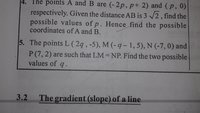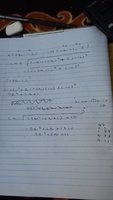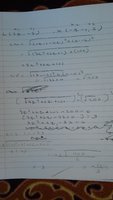You are using an out of date browser. It may not display this or other websites correctly.
You should upgrade or use an alternative browser.
You should upgrade or use an alternative browser.
i dont even know how to start, i am confused , can someone explain me how to do it? question 5
- Thread starter dev644
- Start date
I don't understandwhat it mean?Okay, let me ask you if you understand what is meant by \(LM\) and \(NP\)?
I don't
I don't know how to answer itTo add to MarkFL question, what does it mean for LM = NP? (you 1st must know the answer to MarkFL's question)
- Joined
- Nov 24, 2012
- Messages
- 3,021
I don't understandwhat it mean?
It typically means the length of the line segment having the given endpoints. How do we determine the length of a line segment?
pka
Elite Member
- Joined
- Jan 29, 2005
- Messages
- 11,978
As far as I know there is no standard notation. The most common is that \(\displaystyle \overline{LM}\) is the line segment with endpoints \(\displaystyle L~\&~M\), while \(\displaystyle LM\) is the length of \(\displaystyle \overline{LM}\).Okay, let me ask you if you understand what is meant by \(LM\) and \(NP\)?
So \(\displaystyle {LM}=\sqrt{|2q-(-q-1)|^2+|-5-5|^2}\)
- Joined
- Nov 24, 2012
- Messages
- 3,021
As far as I know there is no standard notation. The most common is that \(\displaystyle \overline{LM}\) is the line segment with endpoints \(\displaystyle L~\&~M\), while \(\displaystyle LM\) is the length of \(\displaystyle \overline{LM}\).
So \(\displaystyle {LM}=\sqrt{|2q-(-q-1)|^2+|-5-5|^2}\)
I also prefer the overline notation, but I was hoping the OP would recognize that it's the distance between two points that we can use to compute the length of a line segment.
0I also prefer the overline notation, but I was hoping the OP would recognize that it's the distance between two points that we can use to compute the length of a line segment.
- Joined
- Nov 24, 2012
- Messages
- 3,021
I get:
[MATH]\overline{LM}=\sqrt{(-q-1-2q)^2+(5-(-5))^2}=\sqrt{(3q+1)^2+10^2}=\sqrt{9q^2+6q+101}[/MATH]
Do you see that you simply forgot the 10 was being squared, otherwise your radicand would have been correct.
Can you now find \(\overline{NP}\)?
[MATH]\overline{LM}=\sqrt{(-q-1-2q)^2+(5-(-5))^2}=\sqrt{(3q+1)^2+10^2}=\sqrt{9q^2+6q+101}[/MATH]
Do you see that you simply forgot the 10 was being squared, otherwise your radicand would have been correct.
Can you now find \(\overline{NP}\)?
ŘI got square root 200 as an answer for NP. | |||||||
- Joined
- Nov 24, 2012
- Messages
- 3,021
I got square root 200 as an answer for NP.
Okay, good. Now equate the two radicands, and solve for \(q\). What do you get?
Steven G
Elite Member
- Joined
- Dec 30, 2014
- Messages
- 14,603
5-5 is 0 so 5--5 is not 0 You know that!!I don't now what is wrong , I can't solve that. And , should the expansion be placed inside the square root and be calculated , this is confusing me. See my working below.thx
View attachment 11842
I
Have already got it , thxso muchI get:
[MATH]9q^2+6q+101=200[/MATH]
[MATH]9q^2+6q-99=0[/MATH]
[MATH]3q^2+2q-33=0[/MATH]
[MATH](3q+11)(q-3)=0[/MATH]
[MATH]q\in\left\{-\frac{11}{3},3\right\}\quad\checkmark[/MATH]



